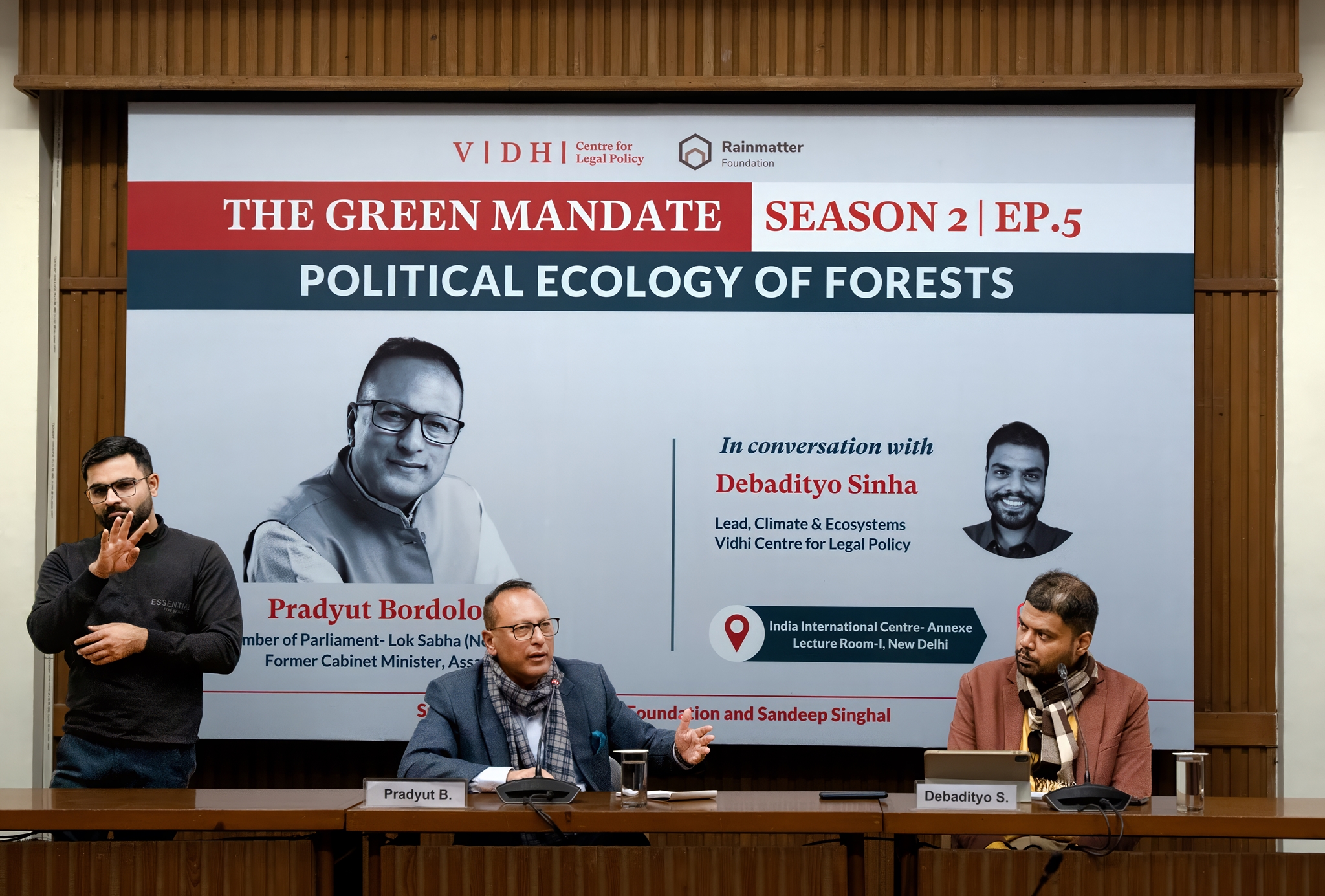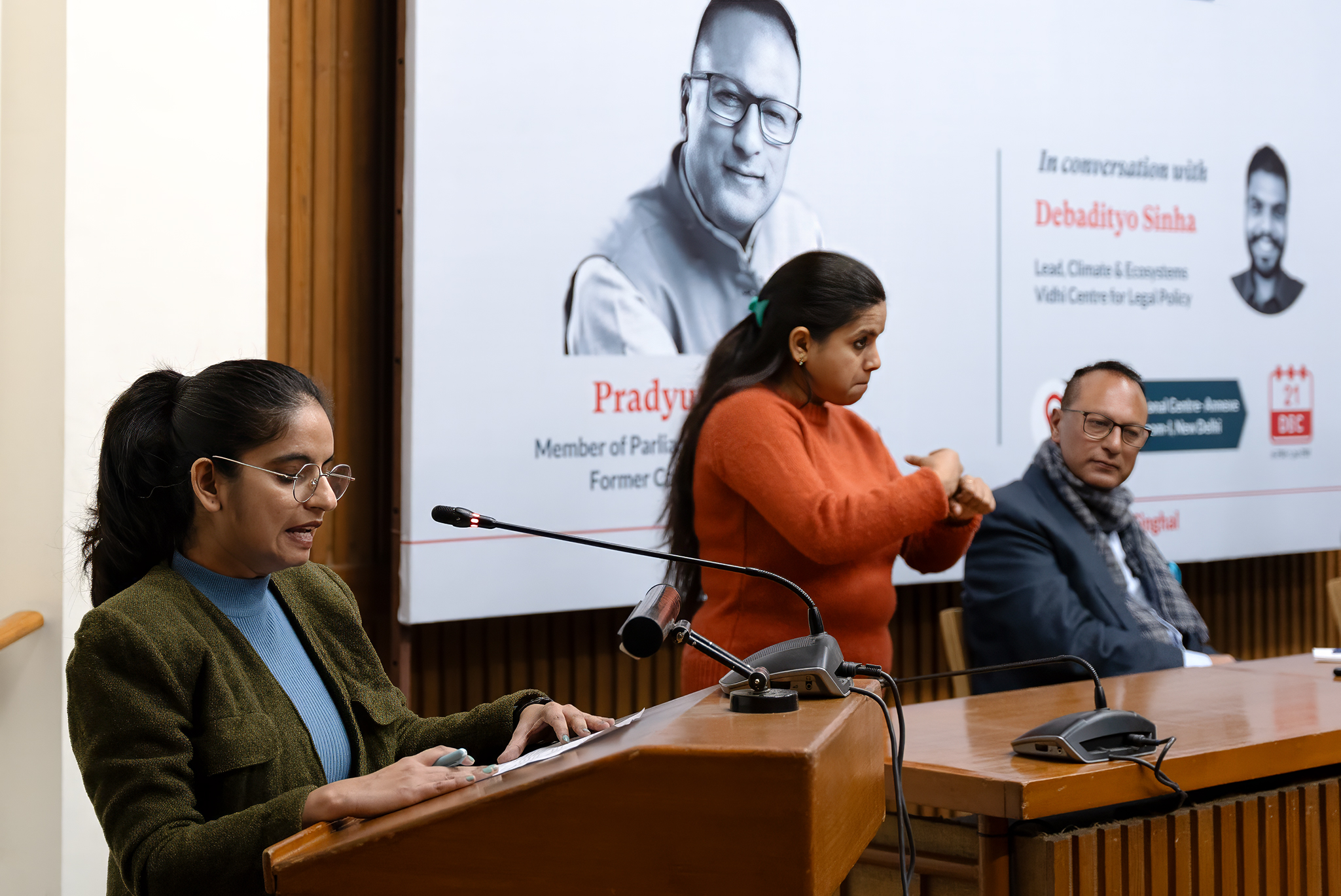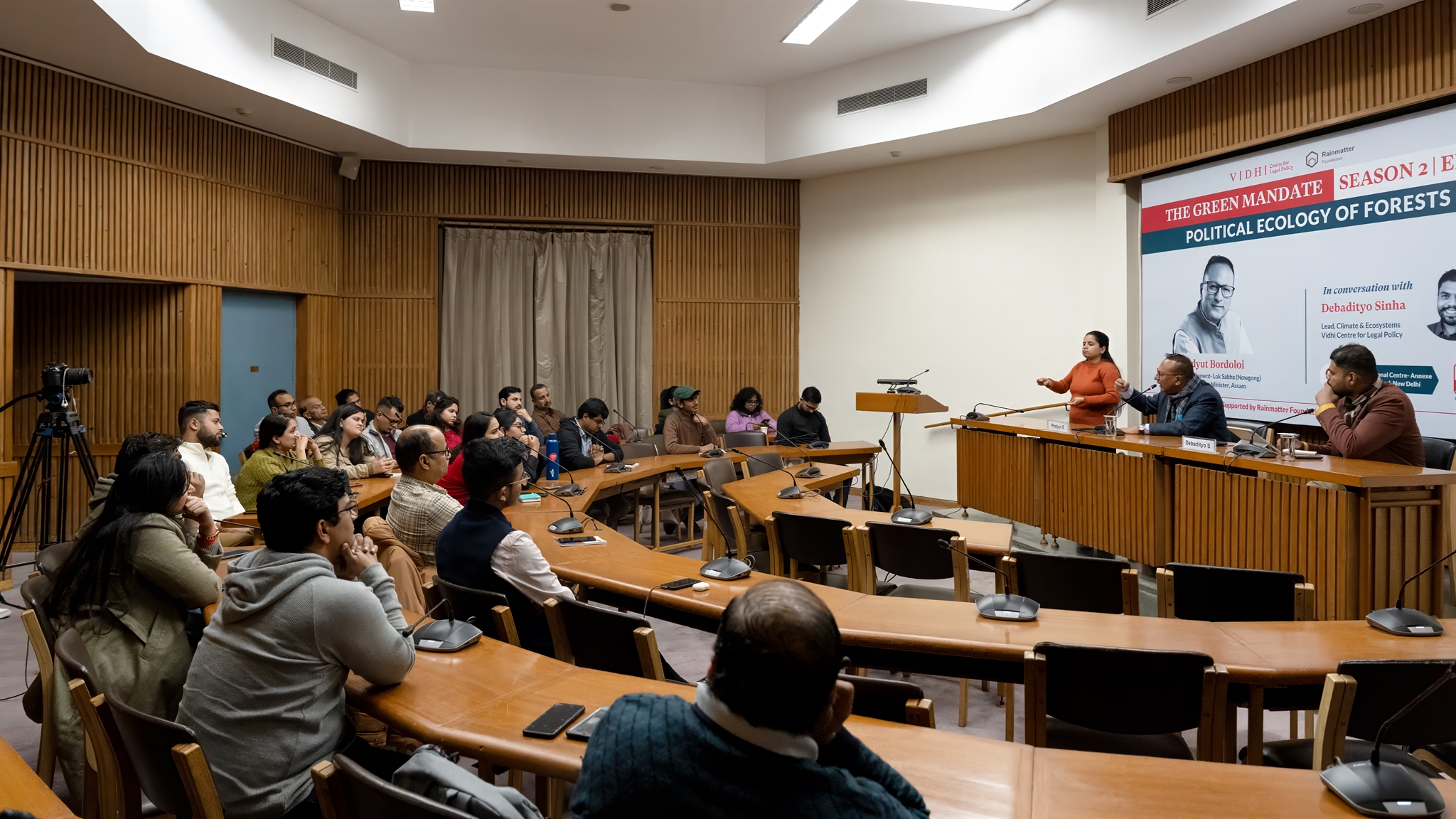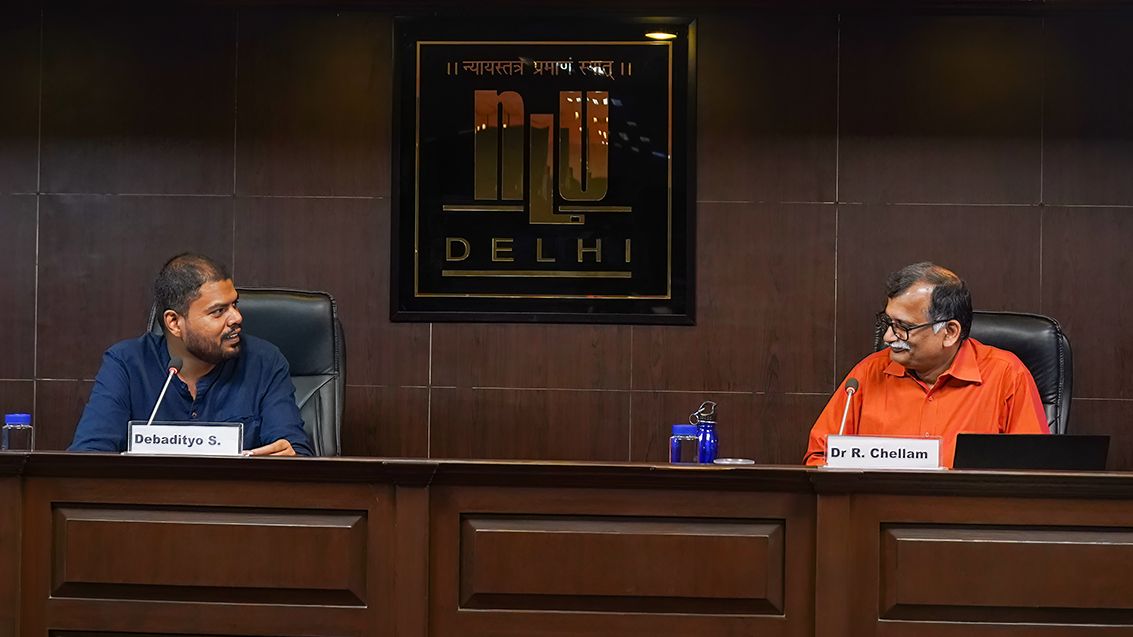The Vidhi Centre for Legal Policy and Rainmatter Foundation organised the fifth episode of THE GREEN MANDATE- Season 2 on ‘Political Ecology of Forests’ with Mr. Pradyut Bordoloi, Member of Parliament (Lok Sabha from Nowgong) and Former Cabinet Minister, Assam at India International Centre Annexe, New Delhi on 21st December 2023.
Forests have played a pivotal role in shaping human history, intricately woven into the fabric of our societies, economies, and the well-being of our ecosystems. The very essence of a forest has undergone profound transformations, influenced by human needs and evolving perceptions. From colonial times to post-independence, the governance and management of Indian forests have been markedly impacted by economic policies and the developmental agenda of governments.
The discussion in the fifth episode of THE GREEN MANDATE Season 2 focused on how political agendas and economic policies impact the state of forests in India. Drawing on his personal experiences, Mr. Bordoloi shared his insights as a politician deeply involved in forest, wildlife, and climate change as a Member of Parliament and former Forest Minister in the Assam government. He was also part of the Joint Parliamentary Committee on the Forest (Conservation) Amendment Bill of 2023 and one of the six members of the Committee who filed a dissent note.
Below is a brief summary of the discussion. For detailed points, please refer to the video.
Question: When we look at our country’s history, despite the huge population density we have succeeded in conserving our wildlife fairly well. Whether the Rhinos in North East, or Gir lions in Gujarat, or the Gharials in Chambal- or the iconic Project Tiger- all these would not have been possible without a strong political will. From bringing forest and wildlife under the Concurrent list, reforming national forest policy, or pumping in money to State-driven conservation efforts- The Indian government has been quite responsive. In your opinion, in India what influenced the conservation strategy of the country post independence- is it the active and vibrant civil society, financial investments by international NGOs, regional politics or the personal interest or reputation of political leaders? How do these power dynamics at local, regional and global scale influence the management of forest resources?
During Indira Gandhi’s first tenure as the Prime Minister, she acknowledged the existing state of affairs – rampant hunting, poaching, and sale of animal skins in open markets. In response, her government passed the Wildlife Protection Act in 1972. Later, the Forest Conservation Act 1980 was passed in her second tenure. Mr Bordoloi calls these legislations ‘epoch-making’ – laws that became the basis for wildlife conservation in India. By discussing these instances, he concludes that empowered and sensitised politicians can draw from international conventions to implement sound conservation policies. Without the will of politicians, conservation efforts will remain futile. On this point, Mr Debadityo comments that environmental sensitization must improve political will.
“Politicians, if sensitised and educated, can make positive change.”
Mr. Pradyut Bordoloi
Question: A prominent critique of the Wildlife Protection Act is that it is a fortress conservation model (creating protected areas where ecosystems can function in isolation from human disturbance). However, 90 percent of the Protected Areas have people living inside them. But, we know for sure, that human greed has no end- the intensity and scale may differ- but if allowed, we would like to control as much land as we can within our ownership- whether its corporations, government departments or local people. We have enough examples of Wildlife Sanctuaries and National Parks with villages inside living peacefully, including tiger reserves- but several of them have lost their tigers and other wildlife owing to human disturbances. At the same time, we cannot deprive people living inside forests of development and social welfare benefits (such as roads, electricity and other basic infrastructures) as the rights of any citizens of India. And there are corporations who want to build big infrastructures in forests. In this situation, what is the solution for balancing these competing interests – the conservation of species on one hand, the social welfare of forest dwellers or and infrastructure development?
There has been perennial conflict between forest dwellers living in fringe areas and forest officials. Mr Bordoloi highlights that we need conservation measures backed by pragmatic policies. This policy must be practical and local region-centric. A simple application of abstract, bookish laws will not be practical. In this regard, Mr. Bordoloi highlights that the population is increasing, and everybody requires space to live. The only space left is the protected areas, so people try to intrude into notified reserved spaces for space and shelter. To deal with such a situation, Mr Bordoloi suggests joint forest management policies, which should be adopted and implemented in a flexible manner respecting local people. These characteristics would ensure that forest dwellers can gainfully and constructively obtain some degree of economic benefit from forest products. This will incentivize local people to cooperate with forest officials without causing degradation or deforestation. Moreover, it would resolve the problem of local livelihood. Most importantly, such practices would make local communities keener to participate in protection measures.
To substantiate his point, Mr Bordoloi talks about his experience of the ‘One Horn Rhino’s’ conservation in Assam. He mentions that his predecessors in the Assam government had actively excluded local youth in upper Assam from being employed as forest guards in Kaziranga National Park. The local ethnic communities around Kaziranga were not happy with their non-involvement. This caused a devastating effect, where more than 100 rhinos were killed. Eventually, when Mr Bordoloi took command of the environment portfolio, he took note of the local communities’ grievances. He got a resolution passed by the cabinet and thereafter engaged the local youth as forest guards. This ensured that their extensive knowledge of Kaziranga’s topography was used constructively – to assist in protection and stop poaching.
“Suppose a road is to be constructed near the border, which goes through a Protected Area (forest). According to forest laws, such construction would not be allowed. However, in areas where Chinese incursions are occurring, you have to build that road in the national interest. These cases are exceptions. And I am not against this particular amendment (in the Forest Conservation Act)…. But, I have a problem when existing protected areas are proposed to be liberalised in the name of commercialization, particularly for the building of more resorts. There are ecologically sensitive zones. Allowing resorts and excessive commercialization in these areas will kill the unique wildlife characteristics and the protected areas. This is what I objected to and filed a selective dissent note (to the Joint Parliamentary Committee on Forest Conservation Bill) which sought to amend these points. But we were not allowed. ”
Mr. Pradyut Bordoloi
Question: The idea of forests undergoes a constant change in public perception; the British era defined forests as spaces for hunting, timber collection, and forest use. While India’s independence and the tenure of Indira Gandhi brought favourable legislation for eco-protection, the post-liberalization period in 1991, the government’s emphasis shifted to ensure calculated economic development. To increase GDP numbers, governments and corporations have begun to see forest and natural resources as commodities for development. Recently, there has been an increasing focus on developing ‘safari’ and ‘eco-tourism’ services to obtain commercial benefits from forests. Even though these forests serve as natural habitats for hyenas, tigers, and small carnivores as stepping stone habitats and wildlife corridors that shelter animals during periods of distress, what social and political factors are driving people’s perception – to view forests not as subjects providing ecosystem services, but as commodities for commercial benefit?
Mr Bordoloi starts by acknowledging any government’s most important policy objective: to increase employment, income, and standard of living. However, an equilibrium needs to be held between economic development and environmental protection. As someone who has served as the Minister of Power and Environment during his time at the State Assembly of Assam, he says that maintaining this equilibrium poses a problem –bipolar syndrome. Here, it is one’s burden to set industries and projects and allow mining operations while preserving the ecosystem. Nevertheless, Mr. Bordoloi emphasized that conservation cannot be ignored, and protected spaces cannot be commercialized unscrupulously because climate change and carbon sink challenges continue to loom. For this reason, he dissented from the Joint Parliamentary Committee dealing with the Forest Conservation Amendment Act because this legislation’s primary purpose was the commodification of forests. It allowed protected and reserved forests for corporate use.
Mr Bordoloi argued that a line must be drawn to limit the extent of industrial development to ensure that forest’s pristine qualities and original habitat remain intact. However, he expressed grave concern here. It was not the simple ‘policy’ objective of economic development, but ‘crony capitalism’ appeared to be the purpose behind the Forest Conservation Amendment Act, which made it highly regrettable. To explain the point, he discussed the ‘palm oil mission.’ Despite sufficient knowledge about palm cultivation’s adverse impact on terrain, soil, and biodiversity, the government implemented and subsidised this program in the North-East and Andaman which are the last remaining fragments of rainforest cover. He said that such a project would destroy the final patches of rich biodiversity and natural ecosystems.
Further, Mr Bordoloi mentions that replacing the natural environment with artificial constructions remains grossly inadequate regarding its ecological value. He talks about a ‘zoo’ in Jamnagar to explain his point. He mentions that elephants and other animals from Assam are being captured from their natural habitat and being caged in fancy, fabricated habitats without scientific study into the adaptability of such animals in the terrain and climate of Jamnagar. The zoo can never recreate the natural ambiance of an animal’s original biodiversity, he added. Mr. Bordoloi concludes by remarking that people must realise the need to reinstate existing policies and institutions, which had a stronger say in voicing eco-centric policies and mitigating environmental concerns.



Question: What is our country’s approach to conservation? How has this approach changed, how can it be changed, and are you hopeful about it?
Mr Bordoloi says that he remains hopeful that the existing approach will improve. Anti-people policies, as he refers to the existing dispensation’s actions, would not be perpetuated if they cannot ensure greater good. In this regard, he gives the example of the National Board of Wild Life. Earlier, this Board included vociferous environmentalists and conservationists. They expressed strong opinions, and the Board could override any government misadventures. However, this intellectual tribe has become inanimate, and institutions have become infructuous. The most concerning aspect is that people are petrified.
“The members of the National Board of Wildlife were so powerful that they could overrule any kind of government misadventure. They would become so agitated that they would bang the table in front of us… how can you do this, this is detrimental to wildlife. And we were literally begging with our folded hands.. No. No, No, No. We will correct ourselves. Today nobody rages or raises their voice.”
Mr. Pradyut Bordoloi
Some Selected Audience Questions
What is your take on those provisions of the Forest Conservation Amendment Act 2023, which allows for constructions of strategic nature in frontier regions?
Mr Bordoloi reiterates the point about ‘bipolar syndrome.’ He clarifies that concerns of ‘national security’ make a valid exception to conservation efforts in border areas. However, adequate compensation needs to be awarded. Adequate steps must be taken both in terms of money and ecological rejuvenation. Mr Bordoloi makes it clear that over-liberalization and commercialization of wildlife and protected areas without the intention to preserve and safeguard natural habitats to the best extent possible is unacceptable.
How do we make a trade-off in implementing policies for ensuring tribal development on the one hand and environmental conservation on the other? How does ‘bipolar syndrome’ impact this situation?
We need to protect the rights of forest-dependent communities, which are perversely violated when industrial establishments and mining activities displace them. To deal with ‘bipolar syndrome,’ we need localised, pragmatic measures. These initiatives should ensure that affected communities are given their dues and incentives to cooperate in projects of national interest. Subjective measures are necessary because every affected population and the local community are not on equal footing. Such measures will secure greater interests of tribal populations by providing employment and protecting culture, habitat, and lifestyle. However, to realise this idea, policymakers and bureaucracy must work together, and enforcing officials must be sensitised to local communities. Allocation of funds to the Ministry and Departments of Environment is a contentious matter. While the 15th Finance Commission gave 10% weightage to ecology and forests while allocating funds to states, this has failed to incentivize states because state budgets have not increased in the amount. Assam has seen a decline in its forest cover at the ground level.
Further, when asked about the CAMPA (Compensatory Afforestation Fund Management and Planning Authority), the RTI replied that only 35% of the funds had been utilised. This use has been counterintuitive and not tribal-friendly. All in all, only 25% of the funds have been used in the last five years.
Do you feel the need to strengthen accountability in making and implementing policy? Alternatively, do you think we need a certain degree of flexibility in using funds allocated to states for environmental purposes?
Mr. Bordoloi said monitoring and accountability are essential because resources are mostly underutilized. To substantiate this, he gives the example of CAMPA funds. While this money should be used to rejuvenate forests, it is being used to fund air conditioners, cars, microwaves, and other facilities for top officials in the government departments.
To address this issue, the Finance Commission must ensure an equitable allocation of funds. Underdeveloped and peripheral regions should receive higher sums of money. Governments should remain sensitive, and grants made by the 16th Finance Commission must better consider the existing state of affairs. This would ensure that underprivileged states are equally uplifted in terms of economic development and environmental preservation.
To watch all episodes of The Green Mandate, visit our YouTube playlist.


